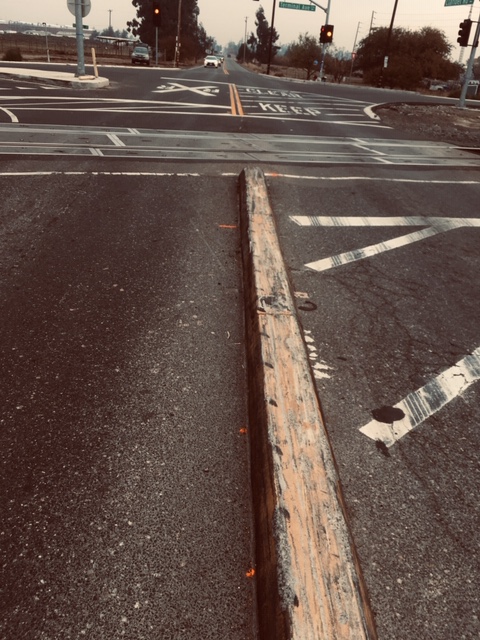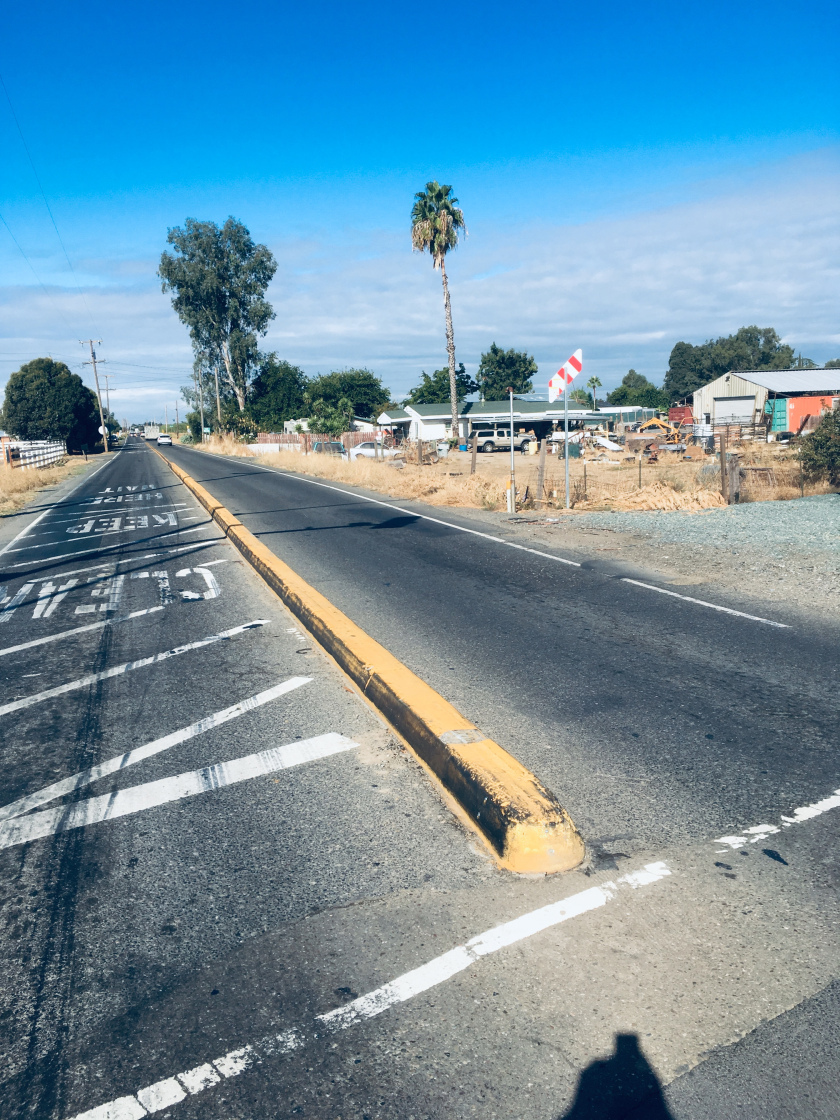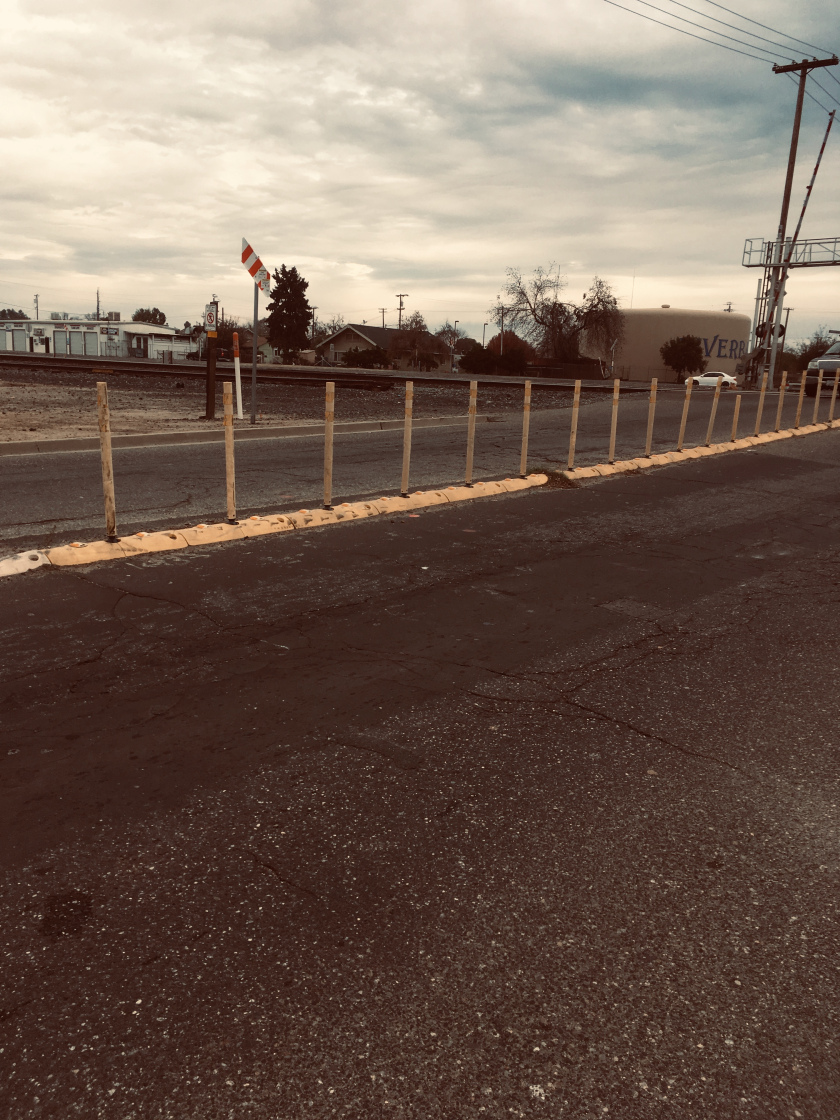
Steve Ringhoff combines an attorney’s regard for law with a journalist’s need to know as he investigates local news, most especially stories involving suspicious circumstances surrounding deadly events. Here, we reprint with permission his latest work from Modesto Explained.
It’s been almost 11 months since Stanislaus Sheriff’s Deputy Tony Hinostroza was killed when his patrol car wrapped itself around a pole at Terminal and Claribel southwest of Riverbank and the California Highway Patrol (CHP) still refuses to release any details about the crash.
In the meantime, a roadway feature which may have played a major role in causing the crash as has again fallen into the same state of disrepair it was in when the deputy crashed.
On November 25, 2018, Deputy Hinostroza headed east on Claribel to join in with other deputies who were actively in pursuit of a vehicle attempting to evade them.
As he neared the intersection with Terminal, he encountered a raised lane barrier built to contain traffic in the eastbound lane when the intersection was controlled by four-way stop signs. It was painted the same color as the center line. It was after dark and the deputy may not have been able to see that the barrier was there.
When built, the barrier had a series of yellow tubes vertically atop the barrier. Over time, these tubes had been knocked off.
Photo one is of the barrier on Claribel taken a couple of days after the crash.
Photo two is of the barrier taken a few days after photo one and AFTER it was fixed by the Stanislaus County public works folks. Note: Pictures taken after the fix were published by the Bee without saying the photo was of the repaired barrier.
Photo three is of the barrier taken this week. The small reflective signs which serve to show the existence of the barrier, evident in photo number two, are gone. The sides of the barrier are again blackened, apparently from tires rubbing against them.
Photo number four is of the next roadway crossing of the railroad tracks to the north, within the City of Riverbank. Note the vertical posts AND the configuration of the barrier.
Witnesses said that the patrol car hit the barrier and lost control, sliding sideways before turning, then rolling with the impact centered on the left pillar, right above the deputy. He died instantly.
With the silence from the CHP, despite formal repeated requests under the California Public Records Act beginning last March, we must rely on what I call “observational journalism.” This simply means that the reporter reports on what they saw.
Two days after the crash, there were markings on the roadway put down by CHP investigators. These markings put down by the CHP marked the path of the deputy’s car. These included scrapes on the barrier and on the roadway.
To my eye, the marks put down by the patrol car, including gouges which look like they are from the rim of a deflated tire—rim marks—indicate that the patrol car straddled, at least for a time, that barrier.
The gouges are off and on, which could indicate the brakes had been applied as ABS pulsed the brakes off and on, and could explain why several gouges were made instead of one long gouge.
Whether or not the brakes had been applied and for how long should have been known within days of this crash. The patrol car was equipped with an event data recorder, a “black box.” In addition, the data logged would include throttle position, speed, turning moments and other happenings in the five or so seconds before the impact.
That data would be independent of any investigative product of the CHP. In our request for the records we asked specifically for the black box data. That request was refused.
The configuration of the barrier, apart from maintaining the original design, represented a danger. Look back at the barrier built and maintained by Riverbank at the Patterson Road crossing, (photo number four).
If you straddle the barrier on Claribel you have no chance to get back into the proper lane, the barrier is simply too tall and its sides are near vertical. The Patterson Road barrier is lower and more rounded, making recovery possible.
Given the fact that markings or signs atop the barrier apparently cannot be maintained, the question becomes why not remove the barrier? The intersection is now controlled by signals with cross arms synchronized so that the Claribel traffic has a red light when a train passes.
The other question is, why is the CHP withholding information about this crash. CHP headquarters, specifically the Office of Risk Management, takes the position that the report cannot be released until it is “complete.” However, the legislative language governing public requests for information is clear that a request may be made before the report is complete and refused only when disclosure would interfere with “the successful completion of the investigation…”
The CHP at both divisional and headquarters has not specified what investigation is underway and why disclosure of even some of the details would interfere with its completion.
It may be politically bad for the CHP to “point fingers” with its report. For example, it could be thought to be critical of Deputy Hinostroza for the speed at which he was traveling. Or it could be thought to be critical of the Sheriff’s Office for the discretion it affords its deputies in determining when to pursue and at what speeds.
A study of pursuits covering a three-year period showed a substantial number of chases topped 80 miles per hour and about 10 percent hit 100 mph or higher.
Then, there is the relationship problem which might arise if the CHP was thought to be critical of the configuration of the barrier, and/or the failure to maintain those yellow posts which highlighted the existence of the barrier, especially at night.
While this incident occurred when a deputy was driving, presumably, at a higher than normal speed, this question remains: If use of reflector paddles is justified, why aren’t they maintained?





I agree with the author’s article. The CHP should release the report or give good reason not to release it. Engineering is an important part of traffic investigation. If they found something wrong with road engineering they should report it so that the road department can fix.
I encountered a similar problem at Hatch Rd and Santa FE Rd. there was a weird traffic line that with poor lighting I almost went into the other lane of traffic
It seems that local governments do not hire the best engineers for traffic and road construction..
What is the CHP hiding and why are they refusing to release this report? High speed law enforcement pursuits are not uncommon, particularly given the large beat areas our county Sheriffs are assigned; every Sheriff I’ve known has sped to the aid of a fellow officer as the one man/one car policy leaves them vulnerable in many of our rural areas. Hence: the likely Code 3 response.
Unfortunately, lousy engineering and poor maintenance is also not uncommon these days. Put the two together and you can wind up with a deadly mix. This accident DID NOT have to happen! The original photo (the one The Bee didn’t print) shows the neglect in both the design technique and maintenance of a critical part of our infrastructure, a fact which could’ve likely been remedied at minimal expense to the city, county or agency responsible…. but instead, we lost another officer who was simply doing his job: to serve and protect. It’s a heartbreaking article to read, especially when you consider the loss to his family, the Sheriff;s Department and the community as a whole.
There is simply no excuse for this failure to release the report and allow Cal Trans, the train companies, the cities or counties responsible to re-think these so-called “barriers” which, if poorly maintained, become death traps for our patrol officers, fire fighters, ambulance drivers as well as the general public!
Lay out the facts CHP so people can move on with correcting future problems like this….and thanks to Steve Ringhoff for keeping this in the public sphere…..especially since the “roadwork” in question has, within the past 11 months since Officer Hinostroza’s death has already fallen again into dangerous disrepair!